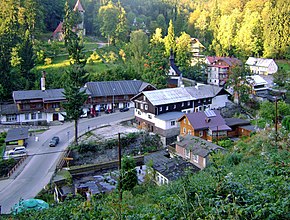Międzygórze
| Międzygórze | ||
|---|---|---|
 Help on coat of arms |
|
|
| Basic data | ||
| State : | Poland | |
| Voivodeship : | Lower Silesia | |
| Powiat : | Kłodzko | |
| Gmina : | Bystrzyca Kłodzka | |
| Geographic location : | 50 ° 14 ' N , 16 ° 46' E | |
| Height : | 560 m npm | |
| Residents : | 700 | |
| Postal code : | 57-514 | |
| Telephone code : | (+48) 74 | |
| License plate : | DKL | |
| Economy and Transport | ||
| Next international airport : | Wroclaw | |
Międzygórze (German Wölfelsgrund ) is a village in the powiat Kłodzki in the Lower Silesian Voivodeship in Poland . It belongs to the urban and rural municipality of Bystrzyca Kłodzka (Habelschwerdt) .
geography
Międzygórze is located in the deeply cut valley of the Wölfel ( Wilczka ) at the foot of the Glatzer Schneeberg , eleven kilometers southeast of Bystrzyca Kłodzka. Shortly before the western entrance to the village, in a narrow ravine, lies the 27 m falling Wölfelsfall ( Wodospad Wilczki ), which is one of the largest natural waterfalls in the Sudetes . Several hiking trails lead from the village up to the Glatzer Schneeberg, offering views of the Glatzer Valley and the Wölfelsgrund dam .
history
Wölfelsgrund was laid out in the royal forest around 1580 as a lumberjack and charcoal burner village and dedicated to the parish church in Ebersdorf. It was initially referred to as Neuwölfelsdorf , was owned by the Royal Bohemian Chamber and belonged to the County of Glatz , with which it shared the history of its political and ecclesiastical affiliation. In 1684, together with other chamber villages in the Habelschwerdt district, it was acquired by the governor of Glatz, Michael Wenzel von Althann , who connected the villages to the Schnallenstein rule , the main town of which was Rosenthal, which is why it was also known as the "rule Rosenthal". With the approval of the Prague Consistory , a wooden chapel with a burial place was built in 1740.
After the Silesian Wars , Wölfelsgrund and the County of Glatz came to Prussia in 1763 with the Peace of Hubertusburg . For the beginning of the 19th century, 404 inhabitants are recorded as well as a burial chapel, a Freirichtergut , a school house, a hunter's house and a board mill. In 1807, as part of the Prussian reforms , subordination was abolished. After the reorganization of Prussia, Wölfelsgrund belonged to the province of Silesia from 1815 and was initially incorporated into the district of Glatz. In 1818 it was reclassified to the Habelschwerdt district , to which it belonged until 1945.
In the 19th century, Princess Marianne von Oranien-Nassau , wife of Prince Albrecht of Prussia , promoted the economic development of the place into a mountain health resort. Roads and paths were laid out, a sanatorium, several hotels, villas and boarding houses were built. Thanks to its scenic and protected location and mountain slopes with guaranteed snow in winter, Wölfelsgrund quickly developed into a popular excursion and winter sports destination. In 1939 there were 706 inhabitants.
As a result of the Second World War , Wölfelsgrund was placed under Polish administration in 1945, like almost all of Silesia , and renamed Międzygórze . The German population was expelled. Some of the new residents were displaced from eastern Poland . From 1975 to 1998 Międzygórze was assigned to the Wałbrzych Voivodeship (German Waldenburg ). Since the entry into force of the Two-Plus-Four Treaty on March 15, 1991, with which Germany renounced the areas east of the Oder-Neisse Line , these areas have also belonged to Poland under international law .
Attractions
- The parish church of St. Joseph ( Kościół Św. Józefa ) was built as a burial church in 1740–1742 and rebuilt in 1920. Hieronymus Richter created the painting of the main altar at the end of the 19th century. The crucifixion group in front of the church is from 1781.
- The branch church of the Holy Cross ( Kościół Krzyża Św. ) Was built in 1911 as a donation from Prince Albrecht as a Protestant church in neo-Romanesque style. Today it serves as a Catholic church and has a modern interior.
- In the village there are still some wooden houses built in the 19th century in the Swiss and Norwegian style .
- At the entrance to the village there is the Wölfelsfall ( Wodospad Wilczki ) [see section Geography]
- Below the village, in the Urnitztal gorge, there is a reservoir that was built in 1907 and serves as a flood retention basin.
- On the pointed mountain ( Góra Igliczna ) that the parish is Woelfel village belonging Sanctuary of Lady of the Snows . It can be reached from Międzygórze in about an hour.
Personalities
- Richard Muther (1860–1909), German art historian, died in Wölfelsgrund
- Willy Geisler (1886–1952), German composer
- Alfons Weiser (* 1934), German Roman Catholic theologian and exegete
- Rudolf Jaenisch (* 1942), German molecular biologist and geneticist
literature
- Joseph Kögler : The chronicles of the county Glatz. Revised by Dieter Pohl . Vol. 4, ISBN 3-927830-18-6 , pp. 70-74.
- Dehio -Manual of Art Monuments in Poland Silesia. Deutscher Kunstverlag Munich Berlin 2005, ISBN 3-422-03109-X , p. 612.
- Hugo Weczerka (Hrsg.): Handbook of the historical places . Volume: Silesia (= Kröner's pocket edition . Volume 316). Kröner, Stuttgart 1977, ISBN 3-520-31601-3 , p. 569.
- Verlag Aktion Ost-West e. V .: The Glatzer country. ISBN 3-928508-03-2 , pp. 118-119.







